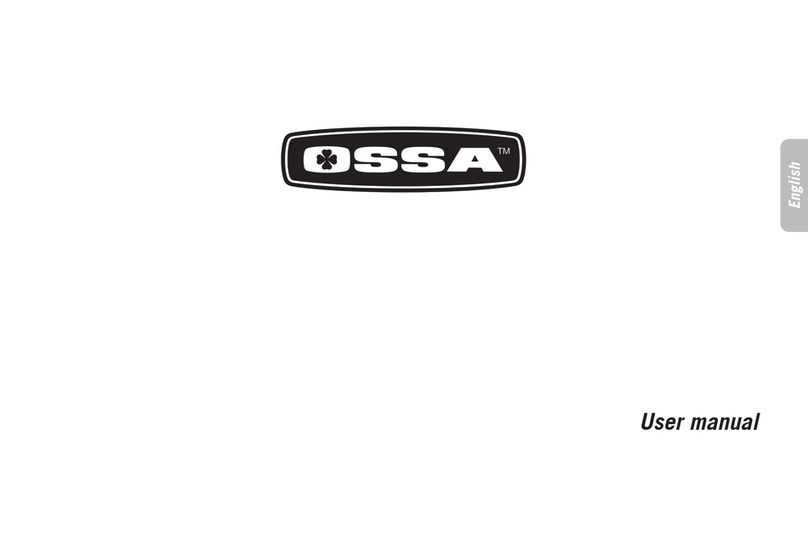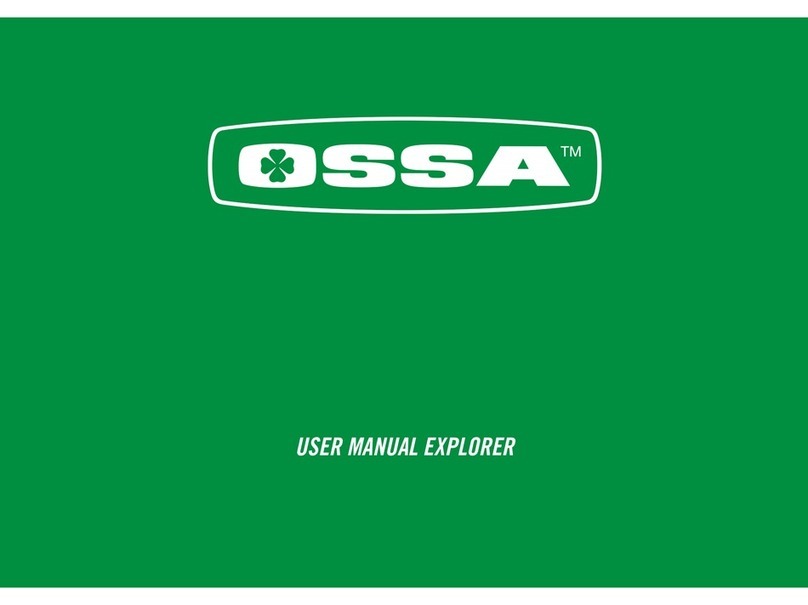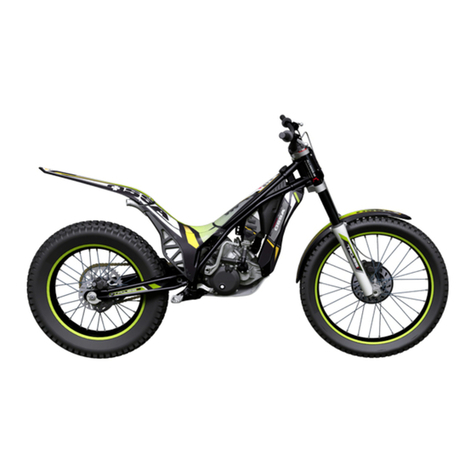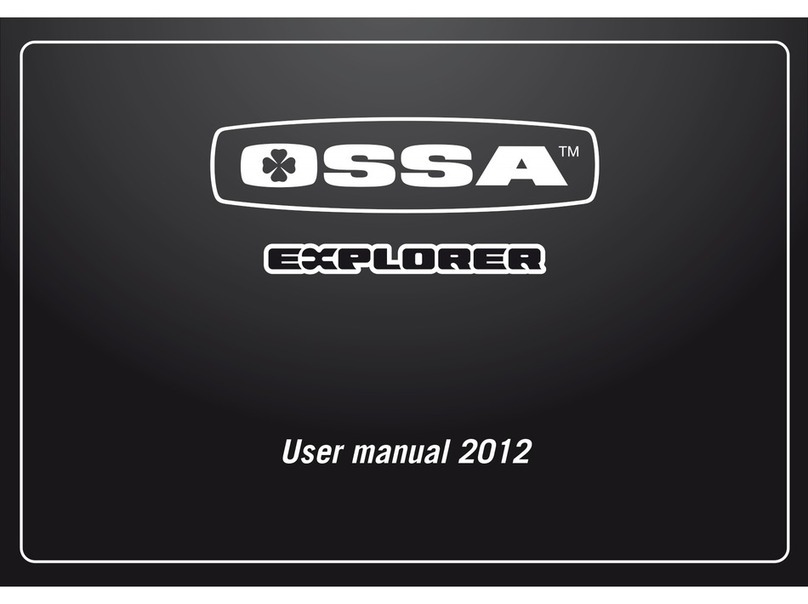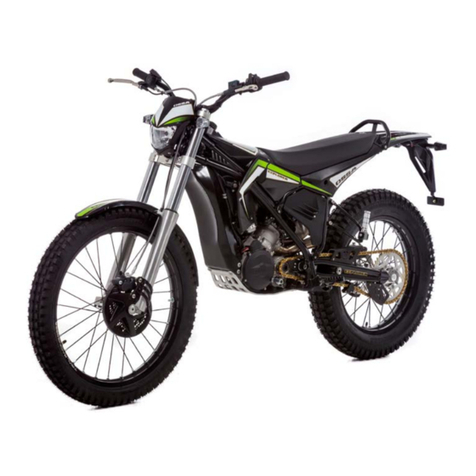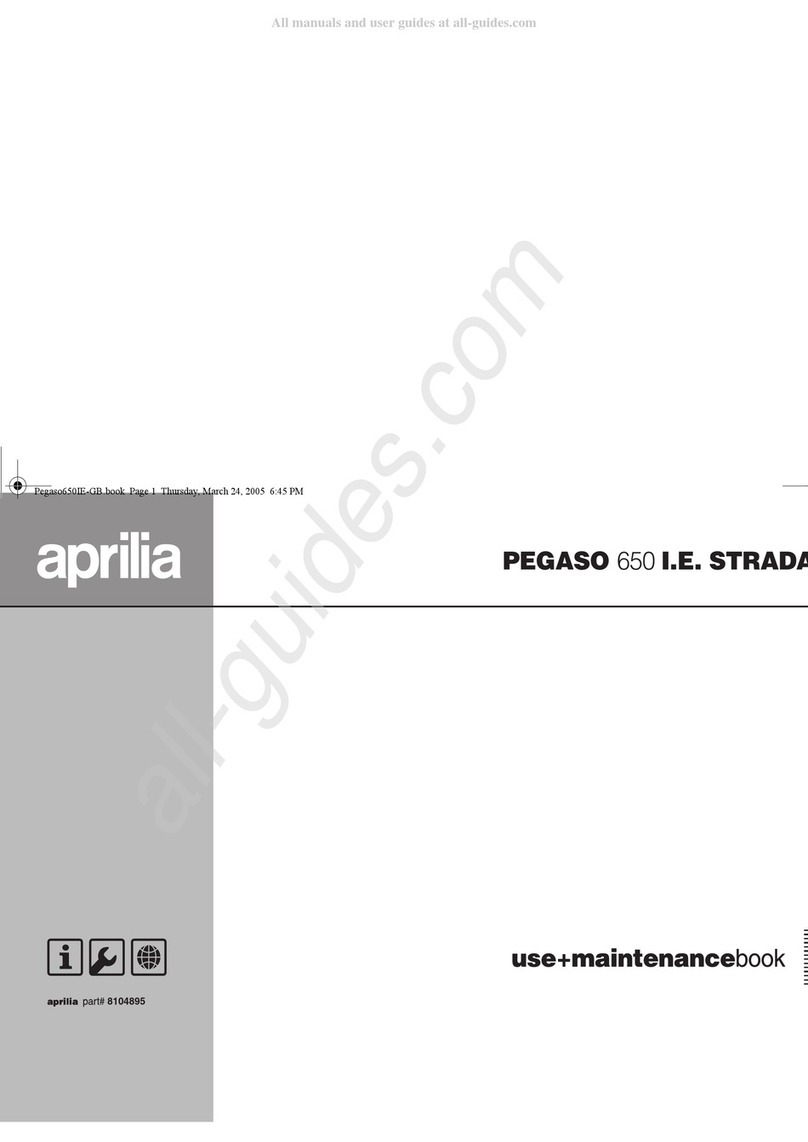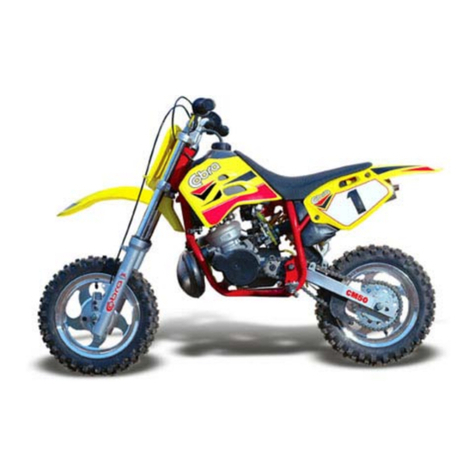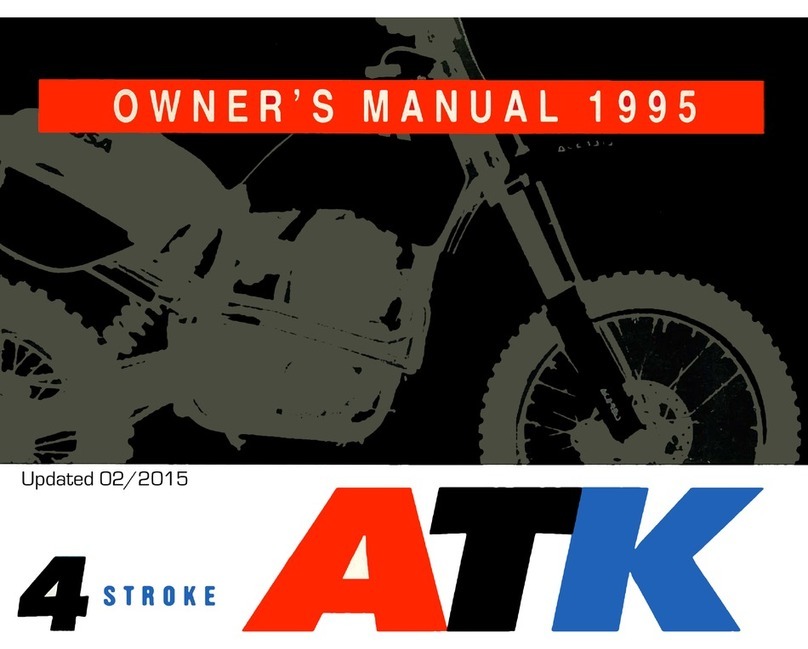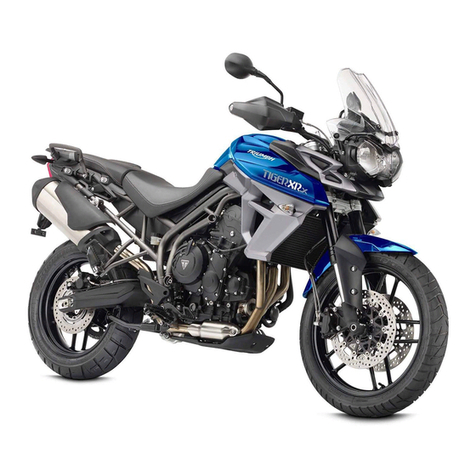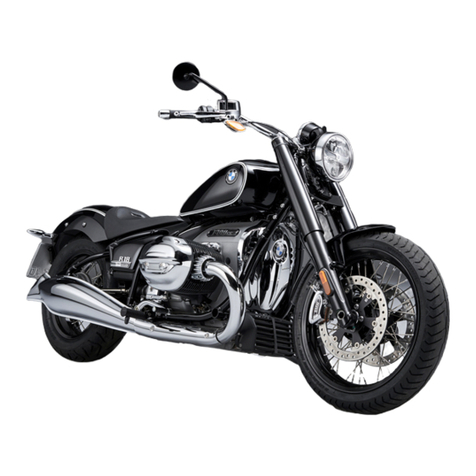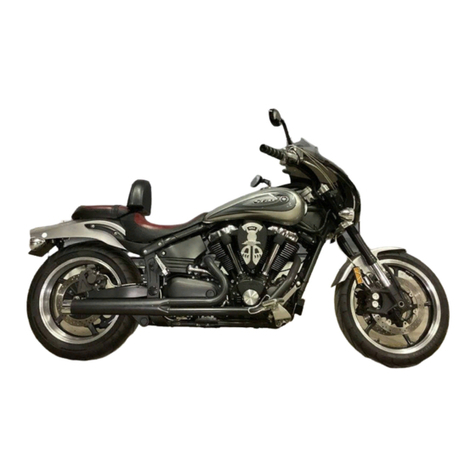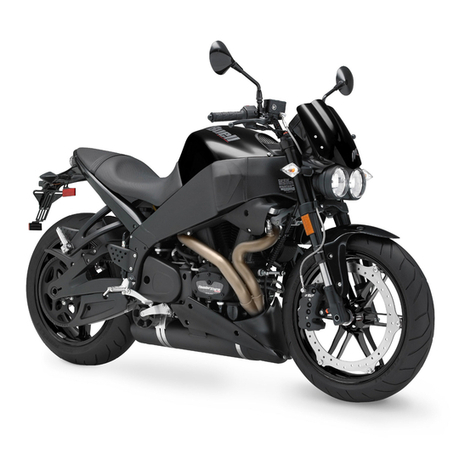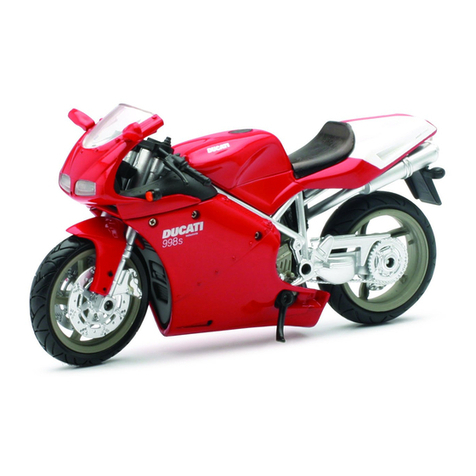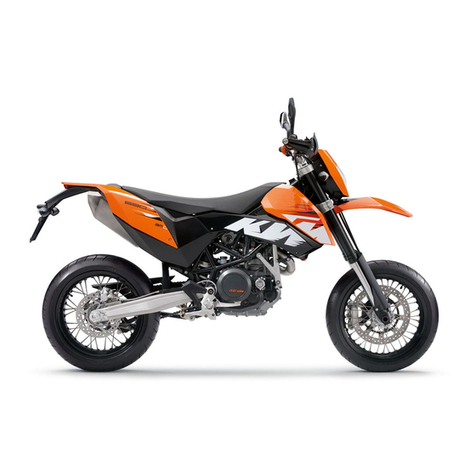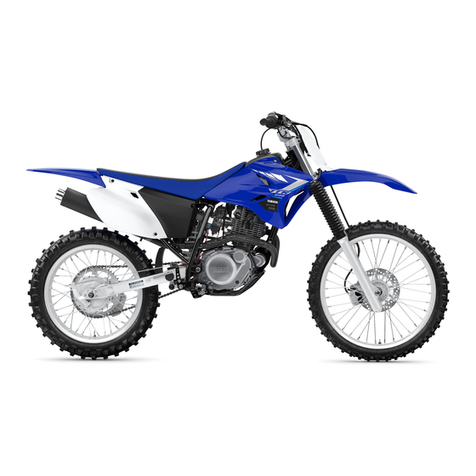Ossa TRi User manual

OSSA TRi and Explorer workshop manual
USER MANUAL TRi

3
OSSA TRi - User manual
Introduction
We at OSSA Motor would like to thank you for purchasing one of
our products.
It is very important that you read this User’s Guide to ensure the
correct functioning and maintenance of your new TR.
As the owner of an OSSA motorcycle, you are the member of an
exclusive group. You have just acquired a unique model, the first
model to be produced since the relaunching of OSSA. The TR
is the “visiting card” for our new OSSA Factory. It marks the co-
meback, after a 25-year interval, of the legendary brand with the
clover logo, which in the 1960s and 1970s earned itself a solid
international reputation outside the frontiers of the motorcycling
world. This is a really special article that will form part of the his-
tory of the brand, of trial racing and of motorcycling as a sport.
The TR is a motorcycle that has been conceived for competition
and then adapted to traffic regulations for use on public roads. It
has been specifically designed for trial competitions, which means
that its features are ideal for such conditions. It is extremely light
in weight, both its gears and transmission systems and the dis-
tribution of its component parts have been arranged with careful
attention and make it a revolutionary machine that is technically
extremely advanced.
OSSA motorcycles have been designed, assembled and tested by
experts, and each of its parts has been produced under the su-
pervision of OSSA engineers so as to obtain the best possible re-
sults and the best possible performance.
At OSSA Motor we know that each motorcycle model is unique
and has its own features, which is why we dedicate so much time
to the research and design for each item.

4OSSA TRi - User manual 5
OSSA TRi - User manual
Both your safety and the safety of others are very important when
riding a motorcycle.
Some important advice for using your motorcycle correctly is de-
tailed below.
- Always drive in a responsible way.
- Always use a helmet.
- This motorcycle is designed to be used in both urban and rural
areas. It should be used, however, while respecting other people
and the environment. If, in your geographical area, the use of
motorcycles in rural areas is restricted, you must respect the law.
- Always wear appropriate clothing and protective accessories.
Gloves, boots and thick trousers, among others, are recommen-
dable. Do not wear baggy clothing that might get caught on a
mechanism in the motorcycle.
- Be careful with the exhaust system! The exhaust system gets
extremely hot during and after use of the motorcycle. In the event
of suffering burns, see a doctor as soon as possible.
- Take the time necessary to become familiar with your new mo-
torcycle.
- Make sure your motorcycle is serviced regularly to avoid break-
downs while driving.
-Never ride with passengers
- Never ride if you have consumed alcohol or any type of substance
(medication, drugs) that might affect your driving capability.
- Moderate speed. Do not exceed 63 KPH (40 MPH).
- Do not cross water areas.
- Do not release your hands from the handlebars.
- Do not perform risky maneuvers and stunts.
- Do not use your motorcycle for transporting or towing loads. In
the event of needing to carry loads, always use the box under the
seat. This load may be light-weight and small in volume so that
driving is not affected. Ensure that there are no loose leashes or
other elements that might get caught inside a mechanism. Never
apply additional weight to the handlebars, fork or mudguards. Be
specially careful when transporting any type of load.
- Do not clean the motorcycle with pressurized-water equipment,
since this may damage the parts.
Safety
Important
Read this manual thoroughly and keep it in a safe place. This
manual provides technical information necessary for keeping your
new OSSA TR motorcycle in full working condition. It provides
information on common aspects for the motorcycle’s upkeep and
fine tuning. In the event of questions or queries on aspects not
mentioned in this manual, you should consult the OSSA official
distributor or a specialist engineer.
Follow each stage of the instructions provided below for obtaining
good results.
These instructions are accompanied by icons to make reading
quicker and easier.
ATTENTION – This symbol indicates that special
attention must be paid!
INFORMATION – Informative note, advice.
Some of the indications specified in this manual are to prevent
possible harm from being inflicted on people or material. Not
following the instructions may result in serious consequences,
which could put people’s lives at risk.
This manual has been put together with the OSSA TR current
layout. However, OSSA Motor reserves the right to make changes
tothis layout without prior notification to consumers. In the event
of this taking place, your dealer will provide you with the relevant
information.
-This motorcycle has been designed to
carry one person only. Never ride with
passengers!
-Do not carry loads.
-Any additional weight could destabilise
the motorcycle which may provoke
accidents that incur serious injury or even
death.

6OSSA TRi - User manual 7
OSSA TRi - User manual
Contents
Introduction 3
Important warning 4
Saferty 5
Contents 7
Technical specifications 8-9
Recommendations 10
Section 1 - Components 11
Location 12-14
Multi-function box 15-22
Control pad 23
Front suspension
Settings 24
Air bleed 24
Rear suspension
Settings 25
Air bleed 25
Anti-theft immobilizer 26
Start lever 27
Fuel tank 28
Upper section 29
Section 2 – Maintenance and basic operations 31
Maintenance grid 32-33
Adjustments to the motorcycle controls 34
Electric connections 35
Simplified lighting wiring diagram 36
Simplified injection wiring diagram 37
Air filter 38
Radiator 39
Spark plug 40
Chain
Tension adjustments 41
Lubriction of moving parts 42-44
Tyres
Pressure and condition 45
Control of crankcase oil
Filling up and draining 46
Brakes 47
Torque wrenches 48
Storage 49
Troubleshooting 50-54
Registration, series number and key 56-60
Warranty conditions 61-68
Final considerations 69
Safety

8OSSA TRi - User manual 9
OSSA TRi - User manual
WEIGHTS AND MEASUREMENTS
Wheelbase 1.328 mm
Seat height 655 mm
Ground clearance 340 mm
Fuel tank capacity 2,6 litres
Dry weight 64.5 Kg
Kick-start pedal Forged aluminium
Shift and brake pedal Forged aluminium with retractable toe cap
Technical specifications
Technical specifications
ENGINE
Cylinder size 294,1cc / 272,2 cc / 249,2 cc / 124,9cc
Type 2 stroke inverted monocylinder with reed box admission
Cooling Liquid cooled
Bore x Stroke 79x60 mm / 76x60 mm / 72.5x60mm / 54x54,5 mm
Injection EFI Kokusan Indirect injection
Ignition Digital flywheel CDI Kokusan
Clutch Hydraulic
Start Kickstart
TRANSMISSION
Gearbox 6 speeds
Transmission Primary transmission by gears, final transmission by chain.
Lubrication Mixture 100% synthetic oil lubrication 0.9%
Gearbox and clutch lubrication 450 cc. of Gear Extreme type 75 W oil.
FRAME
Type Made of CR-MO steel tube, with fuel tank and lower part made of forged aluminium
Front suspension Fork with aluminium bars, 40 mm diameter Marzocchi (depending on version) adjustable in
extension and compression
Rear suspension Variable progressive system with TTX OHlins mono shock absorber adjustable in extension and
compression / Ollé mono shock absorber adjustable in spring preload (depending on version)
Front brake 185 mm diameter disc with 4-piston brake caliper
Freno trasero 150 mm diameter disc with 2-piston brake caliper
Front wheel 2.75x21 wheel
Rear wheel 4.00 x 18 tubeless wheel
Engine protector Constructed in AA7075 T6

10 OSSA TRi - User manual 11
OSSA TRi - User manual
Section 1 - Components
Recommendations
It is extremely important to follow the recommendations below in order to keep your motorcycle in full working order.
- 12 hours of running-in is recommended to ensure that the engine works correctly and for a long-lasting time period.
- It is important to run the engine for some minutes until it reaches the correct temperature to work correctly.
- The engine lubrication is a mixture of petrol-oil with a 0.9% oil proportion. Always use synthetic oil.
- When the motorcycle is new the oil must be changed for the first time after 5 hours of use and for the second time after 12 hours of
use.

1
2
3
4
5
6
7
8
9
10 11
12 13
14
15
16
17 18
19
20 21 22
23
24
12 OSSA TRi - User manual 13
OSSA TRi - User manual
Location of elements
1 Front mudguard
2 OSSA multi-function box
3 Fan and radiator
4 Cylinder
5 Sparkplug
6 Chain guide
7 Front tyre
8 Front fork bottles
9 Front fork stanchions
10 Shift pedal
11 Chain
12 Chain slider
13 Rear sprocket protector
14 Rear tyre
Location of elements
15 Rear break caliper and anti-theft immobilizer
16 Exhaust
17 Kick-start pedal
18 Fuel tank
19 Rear brake disc
20 Swing arm
21 Rear brake lever
22 Crankcase protector
23 Front brake caliper
24 Front brake disc

25
26
27
28 29
30
31
32
33
34
35
36
14 OSSA TRi - User manual 15
OSSA TRi - User manual
Multi-function box
The OSSA TR multi-function box and the indicator lights next
to it provide very useful information at all times. The multi-function
box is a power box system with an LCD screen controlled by a
console with indicator lights, located in the centre of the handle-
bars.
The information displayed on the multi-function box includes:
the number of revolutions made by the engine, speed, distance
covered, total distance covered, time, average speed, maximum
speed, environmental temperature, running time and uptime.
This device has an internal memory unit that stores data like total
Km and total running time, even when it is switched off.
Some features may be personalised: the device can measure in
kilometres or miles. The wheel circumference value can also be
changed.
A temperature sensor warns us with a yellow light (1) when the
engine temperature is excessive.
Another sensor provides a warning with a red light (2) when the
rate at which the engine turns is excessive.
OSSA Multifunction Display
Right button
Left buton Right button
Temperature warning LED
LED warning of
excessive motor rotation
Location of elements
25 Front brake handle
26 Throttle grip
27 Throttle grip mechanism
28 Front brake pump
29 Right fork stanchion regulator
30 OSSA multi-function box
31 Left fork stanchion regulator
32 Clutch pump
33 Lights control pad
34 Clutch handle
35 Headlights
36 Air filter

16 OSSA TRi - User manual
Multi-function box
17
OSSA TRi - User manual
Multi-function box
Functions
RPM: Bar
Bar graph tachometer. The tachometer bar graph displays up to
12,000 rpm.
RPM: Digital tachometer
The RPM appear on the right side, on the second line. The digital
tachometer displays up to 12,000 rpm. The tachometer signal
can be captured from the sparkplug wire.
Warning of gear change due to rpm.
The rpm appear on the right side, on the second line. The digital
tachometer displays up to 12,000 rpm. The tachometer signal is
received from the sparkplug wire.
SPD: Speedometer
The speedometer information appears on the centre of the screen.
It displays up to 399.9 km/hour or miles/hour.
MS: Maximum speed meter
It displays the maximum speed reached during the last operation
after having set the counter at zero.
DST: Distance covered
It appears on the right side, on the second line of the screen. The
TRIP function records the mileage accumulated by the vehicle
since the last RESET.
ODO: Mileage counter
It records the distance or total accumulated mileage for the ve-
hicle. The data is stored in the memory, even when the device is
switched off.
ART: Running time controller
It calculates the total running time. It begins counting as soon as
the engine is switched on.
RT: Total running time controller
It calculates the vehicle’s running time from the last RESET. It
begins to count from when the vehicle starts to move. The data is
stored in the memory, even when the device is switched off.
12/24 hour clock
It displays the current time in 12 or 24 hour clock. It indicates the
temperature of the environment and engine. The display screen
on the upper left shows the environmental temperature. Using an
optional temperature sensor, the screen displays the engine tem-
perature. If excessive, the yellow light comes on.
Indicator that engine turn rate is excessive / Warning of gear
change due to rpm.
If the engine turn rate is excessive a second red warning light will
come on. This function acts as a warning to change gear when a
specific number of rpm is reached. The red light flashes when the
rpm reaches the established value and stops flashing when the
gear is changed.
Technical features
Functions Technical features
Accuracy
Symbol Increasess
Current speed 4 - 399,9 Km/h o M/hSDP0 ,1 Km/h o M/h+ /- 0,1%
0 - 19999 rpm
RPM 10 rpm+ /- 0,1%
Tachometer
Distance covered 0,1 Km/h o M/h+ /- 0,1%
0,0 - 19999 Km / M
DST
Maximum speed MS 4 - 399,9 Km/h o M/h 0,1 Km/h o M/h+ /- 0,1%
TT
Running time 0 - 9999 hours 59 minutes 1 second +/- 0,1%
0 - 12000 rpm
-Variable+ /- 0,1%
Tachometer bar
0,0 - 999999
ODO 1 Km +/- 0,1%
Mileage
1 minute
0 - 999 hours 59 minutes
RT +/- 0,1%
Uptime
1 minute
0 - 9999 hours 59 minutes
ART +/- 0,1%
Accumulated uptime
Each use
12:59:59 - 23:59:59
00:00:00 +/- 0,1%
Clock
Each use
1 year's duration approx
LO +/- 0,1%
Battery low
0 - 3999 mm
---
Tyre size
Input voltage: 9-400 V CA/CC.
Speed sensor: magnetic non-contact sensor
Tachometer input: electrical pulse sensor
Wheel circumference adjuster: 1 mm -3.999 mm (increases of 1 mm)
Running temperature / storage: from 0ºC to 60ºC (from 32ºF to 140ºF) / from -20ºC to 80ºC (from - 4ºF to 176ºF)
Battery / Life: 3V CR2032 / 1 year approx

18 OSSA TRi - User manual
Multi-function box
19
OSSA TRi - User manual
Multi-function box
Time adjuster
Set the time by pressing button
1 repeatedly. To move to the next
digit, press button 3. Confirm the
selection by pushing button 2.
12
Adjustment of the revolution
pulse (PPR)
Note:
This step must only be followed
for those vehicles that change
the PPR pulse type to a specific
turn rate. If you don’t know this
value, press button 2 to move
on to the next screen. Enter the
value by pressing button 1 re-
peatedly. To move on to the next
digit, press button 3. Confirm the
selection by
pushing button 2.
Adjustment of the revolution
pulse (PPR)
The indicator receives an electric
pulse each time the engine turns
(PPR). Default value for 2 and 4
stroke engines: 1 PPR. Enter the
value by pressing button 1 re-
peatedly. To move on to the next
digit, press button 3. Confirm the
selection by pushing button 2. 123
Adjustment of the revolution
pulse (PPR)
Note:
This stage must only be imple-
mented if in the previous stage
the value 0 was entered. Default
value: 1.0. If you don’t know this
value press button 2 to move on
to the next screen. To move on
to the next digit, press button 3.
Confirm the selection by pres-
sing button 2.
1 2 3
Activation of the adjustment
mode
To activate the adjustment mode
for the multi-function box set-
tings, push buttons 1,2 and 3 si-
multaneously for 3 seconds and
then release them.
1 2 3
Select the wheel circumference
Enter the wheel circumference
by pushing button 1 repeatedly.
To move to the next digit, press
button 3. Confirm the selection
by pushing button 2.
Note: If you don’t know the whe-
el circumference, consult the
“Measuring the wheel circumfe-
rence” section. 12 3
Select the speed unit
To select the speed unit between
km/h and m/h, press 1. Confirm
your selection by pressing 2.
2
1
Select the time format
To select the time format change
between the 12 and 24, press 1.
Confirm your selection by pres-
sing 2.
12
Adjustment of the multi-function box settings
After confirming each value, the multi-function box will move straight on to the next screen adjustment until the process is complete.
If no button is pressed, the multi-function box will return to the initial screen after 15 seconds.

20 OSSA TRi - User manual
Multi-function box
21
OSSA TRi - User manual
Multi-function box
Temperature selector
To select the unit of
temperature,either ºC or ºF,
press button 1. Confirm the se-
lection by pressing button 2.
1 2 3
Danger temperature selector
Note:
This stage should only be imple-
mented for those vehicles that
have an optional temperature
sensor. When the motorcycle
temperature exceeds the set
value, right-hand warning light
comes on. Default value: 110ºC
(230ºF).
Enter the value by pressing
button 1 repeatedly. To move on
to the next digit, press button 3.
Confirm the selection by pres-
sing button 2.
1 2 3
Warning temperature selector
Note:
This stage should only be imple-
mented for those vehicles that
have an optional temperature
sensor. When the motorcycle
temperature exceeds the set va-
lue, the left-hand warning light
comes on.
Default value: 90ºC (190ºF). En-
ter the value by pressing button
1 repeatedly. To move on to the
next digit, press button 3. Con-
firm the selection by pressing
button 2.
123
Gear change turn rate selector
When the set rate is near to be-
ing reached, the left-hand war-
ning light will flash, indicating
the need to change gear.
Default value: 6000 rpm
Enter the value by pressing
button 1 repeatedly. To move on
to the next digit, press button 3.
Confirm the selection by pres-
sing button 2.
123
Dangerous turn rate selector
When the set rate is near to be-
ing reached, the right-hand war-
ning light will flash, indicating
that the engine is turning at an
excessive rate.
Default value: 10,000 rpm. En-
ter the value by pressing button
1 repeatedly. To move on to the
next digit, press button 3. Con-
firm the selection by pressing
button 2.
12 3
23
Setting the indicator functions to zero after each use of the vehicle
After each use of the vehicle, it’s possible to set the following
functions to zero, simultaneously:
- Maximum speed
- Distance
- Chronometer
- Maximum temperature
- Maximum turn rate
Confirm that you want to set these functions to zero by simulta-
neously pressing buttons 1 and 2.
Setting the whole multi-function box to zero
Press the RESET button by using a suitable object. The indicator
will boot again, excluding data that corresponds to total accumu-
lated distance and time.
BATT
ERY
CR2
0
3
2
RESET
RESET
CLOSE
OPEN
POSITIVE
BATTERY CR2030
Internal battery
The multi-function box works with a 3V internal battery, type
CR2032. When the battery tension falls beneath 2.45V, the screen
displays the LO indicator. To change the battery, open the lid on
the bottom of the indicator by unscrewing it as is indicated in the
image, using a coin. Ensure that the positive side of the battery is
facing upwards.

22 OSSA TRi - User manual
Multi-function box
23
OSSA TRi - User manual
Control Pad
Screen Options
The multi-function box displays all information on three different
screens. While on, it is possible to see screens 1 or 2. Screen 3 is
displayed for three seconds and then returns to screen 1.
To move from one screen to another repeatedly press button 2
(“Mode”). To edit the distance covered (DST) hold down button 3.
Screen 1:
Screen 1 displays the following information:
- Speed, distance covered, time, environmental temperature, ta-
chometer (bar).
Screen 2:
Screen 2 displays the following information:
- Speed, digital tachometer, running time, uptime, engine tempe-
rature*, tachometer (bar).
Pantalla 3:
Screen 3 displays the following information:
- Maximum speed, dangerous turn rate, accumulated running
time, mileage counter, maximum temperature*.
* optional
Screen Illumination
The multi-function box works by using a 3V internal battery, type
CR2032. To change the battery, open the lid on the bottom of the
indicator by unscrewing it, as indicated in the image, using a coin.
Ensure that the positive side of the battery is facing upwards.
When the multi-function box is powered exclusively by the inter-
nal battery, the screen illumination is partially maintained for 3
seconds when the button is pressed.
When it is connected to the 12V vehicle installation, the illumina-
tion will be brighter and will remain constant for 20 minutes after
the vehicle has stopped.
Sleep Mode
If the multi-function box receives no information for 20 minutes
(wheel signal, turn signal or pressed button) the screen will turn
off, displaying only the time. When the vehicle moves, or by pres-
sing any button, it will start up again.
Measuring the wheel circumference
Method 1:
Measure the diameter of the front wheel. Multiply the diameter
obtained by 3.14. If necessary, convert the measurement into
mm by multiplying the obtained figure by 25.4. The measurement
obtained corresponds to the measurement of the wheel circumfe-
rence.
Method 2:
On a smooth and flat surface, put a mark on the side of the tyre
and in the area where it is touching the ground. Move forward with
the vehicle until the wheel has tuned completely once and the
mark is on the lowest part again. Put a new mark on the ground
at this point. Measure the distance between the two marks on the
ground. If necessary, convert the measurement in mm by multi-
plying the figure obtained by 25.4. The measurement obtained
corresponds to the wheel circumference. To obtain a more accu-
rate measurement, the rider should remain on the vehicle when
the measurement is taken.
1
2
3
6
5
4
See the image with information about the control pad.
1 – Position lights
2 – Cross lights
3 - Long range lights
4 – Lights for changing direction (left – right)
5 – Horn
6 – Button to switch off engine
3 4
1 2
See the image with information about the control pad.
1 – Pilot lamp for change of direction (left – right)
2 – Pilot lamp for cross lights
3 – Pilot lamp for long range lights
4 – Pilot lamp for footrest
Control Pad
The control pad is located on the left handlebar, within reach of the thumb. This control pad can be used to control the lights, indicators,
horn and engine stop.

A
C
B
C
24 OSSA TRi - User manual 25
OSSA TRi - User manual
The front suspension is made up of a fork that fixes the wheel
and the front brake system in place. This fork is formed by the
suspension bars that contain the shock absorber spring and the
suspension mechanism. They are connected to the upper part
where the direction pipe is located, a point of connection between
the fork and the chassis. A regulating screw and an air bleed are
located on the upper part of each suspension bar (see photo).
To regulate the extension, use the screw located on the right sus-
pension bar (Fig. A)
To regulate the compression use the screw located on the left
suspension bar (Fig. B)
Each of the suspension bars also has an air bleed to remove air
that accumulates in the inside of the fork stanchion (Fig. C)
The rear suspension is formed by a single shock absorber spring.
The pre-charge of this spring can be adjusted by turning the too-
thed rings that dictate its direction.
A special key is needed to adjust these toothed rings.
The compression (C), extension (R) and spring pre-charge (see
Fig.)are adjustable in the rear shock absorber.
R
C
Adjustable rings for the spring pre-charge
Rear suspension
Front suspension

26 OSSA TRi - User manual 27
OSSA TRi - User manual
Anti-theft immobilizer
The TR has an immobilization system for protection against
theft.
This system consists of a lock situated in the area of the brake
discs on the rear wheel. It is a mechanism that is operated with a
key and blocks the rear wheel.
IMPORTANT: this key has a code which
is needed for making duplicate copies of
the key. This code should be written down
in the indicated space on the registration
page and series number of this manual.
Kick start pedal
Before starting the motorcycle, you must ensure that the key
switch at the right hand side of the headlight is activated. Also, it
must be in neutral gear. DO NOT try to start in a gear .
The kick-start pedal is part of the mechanism that is used to kick
start the motorcycle mechanically.
To kick start the motorcycle, the kick-start pedal must be sepa-
rated from the bike and moved outwards. Once separated, place
your foot on top and press strongly to turn it counter-clockweise.
It is necessary to ensure that the light signals are working properly,
that the tire pressure is correct and the security and control ele-
ments (brakes and controls) are in good condition.
If the motorcycle has been inactive for a long period
of time, its recommended that the kick-start pedal is
activated gently 3 or 4 times, without actually kick-
starting the motorcycle. This will enable the engine to
move which will help when kick-starting it.
If the motorcycle has been inactive for a very long
period of time, change the oil and petrol because they
might have become degraded. This could affect the
motorcycle’s performance.

28 OSSA TRi - User manual 29
OSSA TRi - User manual
Upper section
Fuel tank
The engine of this motorcycle works with
a mixture of unleaded petrol and 2S oil,
100% synthetic in a 0.9 proportion.
The fuel tank forms a structural part of the chassis
and is located on the front inside part. To fill up with
petrol, open the fuel tank lid, situated on the upper
part, by unscrewing in an anti-clockwise direction.
It’s recommended that a hose or funnel
is used to fill up to avoid spilling the
petrol. This is especially important if the
motorcycle is hot. DO NOT fill up with
petrol when the motorcycle is turned on.
1
2
Remove the upper section. Stage 1
2
1
3
4
Remove the upper section. S
To access different parts of the motorcycle or the motorcycle’s electrical system the upper section should be removed. This section is
made up of 2 parts that are screwed onto the chassis and fitted together.
The first part of this section is located on the front above the fuel tank. Next is the second part of this section which corresponds to the
seat area and rear mudguards.

30 OSSA TRi - User manual 31
OSSA TRi - User manual
Section 2 – Maintenance and basic operations

32 OSSA TRi - User manual 33
OSSA TRi - User manual
Maintenance grid – Engine Maintenance grid - Cycle
__Each year Every 2 years
_
Rear shock absorber
_When damaged_E ach useChassisE ach use
When necessaryBrakes Each useW hen damaged __
Each yearFront suspension Every 2 years __When necessary
_E ach washEach useEach useW hen damagedSwing arm and linkage arms
Front suspension lubricant 60 Hours__ __
When damagedTyres Each use ___
When damagedFront/rear tyre Each use _Each use_
When damagedBrake discs Each use __When necessary
When damaged30 horasWheel bearings Each wash__
When damagedEach useSteering bearings Each wash__
When damagedEach useSecondary transmission Each washEach useWhen necessary
When damagedEach use _Each use5 HoursFront/rear spokes
_When damaged_E ach useEach useFuel tank
When damagedEach use _When necessary Each use
Screw, nuts and fastenings
When damaged_ _First useE ach useCrankcase protector
When damaged_Each use __
Protective stickers
Check / Inspect Replace / Change Grease / lubricate
Adjust Clean
Item
Check / Inspect Replace / Change Grease / lubricate
Adjust Clean
30 Hours
30 Hours
Each wash
Each wash
Each year
Each year
Each year
When necessary
When necessary
When necessary
When necessary
When necessary
When necessary
Wire and throttle grip
Cylinder
Clutch discs
Exhaust
Clutch
Each useE ach washEach use _
_
_
_
Air filter
Each use
Each use
Each use
Each use
Each use
Each use
Each use
60 horas
15 Hours
_
_
_
__
_
_
_
_
__
30 Hours
60 Hours
60 Hours
60 Hours
_
_
_
_
_
__
__
_
_
_
_
_
_
_
__
Silencer
Change / kick-start pedal
Radiator tube and connections
Item
When damaged
When damaged
When damaged
When damaged
When damaged
When damaged
When damaged
When damaged
Transmission oil
Refrigerant
Sparkplug
Reed block
Piston and piston ring

min. 3 mm
min. 3 mm
34 OSSA TRi - User manual 35
OSSA TRi - User manual
Electrical connections
Check the condition of the motorcycle’s electrical connections in
order to ensure they are maintained in good working order.
As seen in the image on the right, these are located at the left side
of the cylinder, between the steering bar and the front headlight,
and in the fuel system apparatus.
Carry out a regular and thorough
maintenance of your motorcycle. Always
use original spare parts and top quality
products to ensure that it works correctly.
Adjustments to the motorcycle controls
The clutch lever is located on the left handlebar grip and is used to activate the clutch mechanism to change gear.
The front brake lever is located on the right handlebar grip and is used to activate the brake caliper of the front brake.
It’s important that the levers and rear brake pedal have a 3 mm give.
It’s important that the levers can be easily activated by the rider while he/she is riding the bike, using the index and middle fingers.
Front brake leverClutch lever

36 OSSA TRi - User manual 37
OSSA TRi - User manual
Simplified diagram of the lights wiring Simplified diagram of the injection wiring

1
2
3
2
1
3
4
38 OSSA TRi - User manual 39
OSSA TRi - User manual
Radiator
The radiator contains the engine refrigerant. To fill up with or add
refrigerant to the radiator, locate the tank lid. To locate this lid,
detach the air filter lid (see page 36 - Air Filter). Once the filter lid
is detached, the radiator lid is visible. Unscrew the lid and pour
in refrigerant.
ATTENTION: Use gloves. Do not open the
lid if the engine is hot. This could cause
burns. Avoid contact of the liquid with
the eyes, mouth or nasal passage. Do not
ingest. In the event of this happening,
follow the product instructions and consult
a doctor.
The radiator has an electric fan to force air through it, as can be
seen in the image below.
To fill the radiator, special coolant should be used
-30ºC.
To ensure that the motorcycle works correctly, periodic controls
must be carried out to check the coolant levels. This will ensure
that the motorcycle is running at an optimum temperature.
Always use special refrigerant for light alloy engines.
Air filter
Air filter. Cleaning and maintenance
The air filter should be controlled periodically. Lift the upper fuel
tank, as you can see in the image on page 29, in order to access
the filter box. Remove the filter rubber cap, unscrew the upper
part of the filter (not necessary to use tools) and take out. To
clean, use water and detergent, leave to dry and then lubricate
with a special liquid for filters. Reassemble using the steps outli-
ned previously but in reverse. Make sure that the parts areput in
their correct positions.
Carry out regular and thorough
maintenance of your motorcycle. Always
use original spare parts and top quality
products to ensure that it works correctly.
Table of contents
Other Ossa Motorcycle manuals
